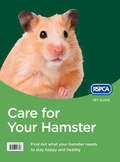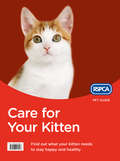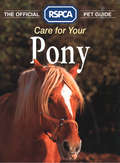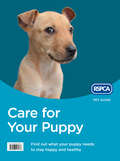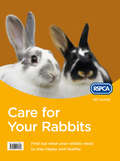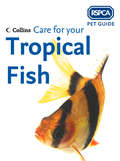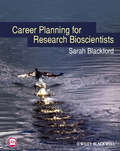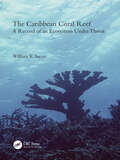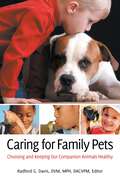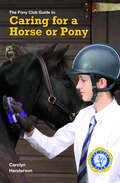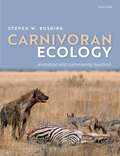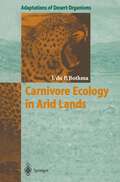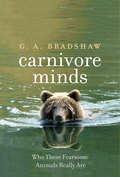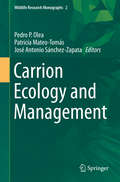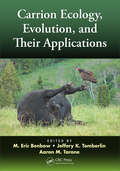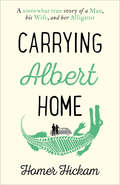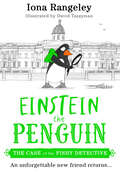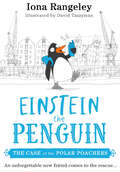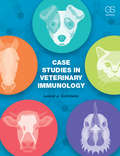- Table View
- List View
Care for Your Hamster (RSPCA Pet Guide)
by RSPCAPublished in association with the RSPCA, the UK’s leading animal welfare charity, this practical family guide is full of expert advice on how to choose a hamster and how best to look after it.
Care for Your Kitten: Find Out What Your Kitten Needs To Stay Happy And Healthy (RSPCA Pet Guide)
by RSPCAPublished in association with the RSPCA, the UK’s leading animal welfare charity, this practical family guide is full of expert advice on how to choose a kitten and how best to look after it.
Care for your Pony (The Official RSPCA Pet Guide)
by RSPCASponsored by the Royal Society for the Prevention of Cruelty to Animals, the RSPCA Guides give you the most helpful and accurate advice on how to best care for your pet.
Care for Your Puppy: Find Out What Your Puppy Needs To Stay Happy And Healthy (RSPCA Pet Guide)
by RSPCAPublished in association with the RSPCA, the UK’s leading animal welfare charity, this practical family guide is full of expert advice on how to choose a puppy and how best to look after it.
Care for Your Rabbits: Find Out What Your Rabbits Needs To Stay Happy And Healthy (RSPCA Pet Guide)
by RSPCAPublished in association with the RSPCA, the UK’s leading animal welfare charity, this practical family guide is full of expert advice on how to choose a puppy and how best to look after it.
Care for your Tropical Fish (RSPCA Pet Guide)
by RSPCAPublished in association with the RSPCA, the UK’s leading animal welfare charity, this practical family guide is full of expert advice on how to choose tropical fish and how best to look after them.
Career Planning for Research Bioscientists
by Sarah BlackfordCareer Planning for Research Bioscientists is an essential careers guide for bioscience doctoral students and postdoctoral researchers. It contains a wealth of information and resources specifically targeted at research bioscientists, with practical strategies to enhance career success in an increasingly competitive job market. Advice on how to write a winning CV together with examples adapted for different jobs is presented, as well as practical exercises to assist with skills analysis and decision making. Profiles of PhD-qualified bioscienstists in a range of professions including academic research, industry, science communication, management and consultancy provide valuable insights into how others have managed their careers, and tactics such as networking and using social media demonstrate how new opportunities can be discovered. The content of this book is aimed primarily at research bioscientists, however much of the advice and information will be a useful reference for other students and researchers looking for an effective career planning strategy. A companion website with additional resources is available at www.wiley.com/go/blackford/careerplanning and you can visit Sarah Blackford’s blog at www.biosciencecareers.org for more information.
Career Planning for Research Bioscientists
by Sarah BlackfordCareer Planning for Research Bioscientists is an essential careers guide for bioscience doctoral students and postdoctoral researchers. It contains a wealth of information and resources specifically targeted at research bioscientists, with practical strategies to enhance career success in an increasingly competitive job market. Advice on how to write a winning CV together with examples adapted for different jobs is presented, as well as practical exercises to assist with skills analysis and decision making. Profiles of PhD-qualified bioscienstists in a range of professions including academic research, industry, science communication, management and consultancy provide valuable insights into how others have managed their careers, and tactics such as networking and using social media demonstrate how new opportunities can be discovered. The content of this book is aimed primarily at research bioscientists, however much of the advice and information will be a useful reference for other students and researchers looking for an effective career planning strategy. A companion website with additional resources is available at www.wiley.com/go/blackford/careerplanning and you can visit Sarah Blackford’s blog at www.biosciencecareers.org for more information.
The Caribbean Coral Reef: A Record of an Ecosystem Under Threat
by William K. SaccoThis book is a visual tour of Caribbean coral reefs between 1968 and 1978. They are the world’s second largest coral reef community and the most threatened. The Caribbean Coral Reef: A Record of an Ecosystem Under Threat offers a priceless historical record made by a photographer who set out to document the major reef species when those reefs were at their prime. Today, coral reefs are under threat as never before and, sadly, most of what is shown in the book's photographs is now gone forever. It is only by comparing the images in this book with what we see now that we are able to fully recognize what we have lost. With its stunning photography and precise, accurate scientific information, this book offers students of coral reefs a wealth of information about this rich, fragile ecosystem. It is also written accessibly for non-academic visitors to the Caribbean reef or anyone interested in the earth’s creatures. Many of the invertebrates will be unfamiliar to most people, and the author reveals fascinating insights into these otherworldly creatures and their lifestyles. Enjoy this field guide to the reefs that were, and savor the beauty of this vanishing environment and its organisms.
The Caribbean Coral Reef: A Record of an Ecosystem Under Threat
by William K. SaccoThis book is a visual tour of Caribbean coral reefs between 1968 and 1978. They are the world’s second largest coral reef community and the most threatened. The Caribbean Coral Reef: A Record of an Ecosystem Under Threat offers a priceless historical record made by a photographer who set out to document the major reef species when those reefs were at their prime. Today, coral reefs are under threat as never before and, sadly, most of what is shown in the book's photographs is now gone forever. It is only by comparing the images in this book with what we see now that we are able to fully recognize what we have lost. With its stunning photography and precise, accurate scientific information, this book offers students of coral reefs a wealth of information about this rich, fragile ecosystem. It is also written accessibly for non-academic visitors to the Caribbean reef or anyone interested in the earth’s creatures. Many of the invertebrates will be unfamiliar to most people, and the author reveals fascinating insights into these otherworldly creatures and their lifestyles. Enjoy this field guide to the reefs that were, and savor the beauty of this vanishing environment and its organisms.
Caring for Family Pets: Choosing and Keeping Our Companion Animals Healthy
by Radford G. DavisThis book helps pet owners fully understand what it means to care for a companion animal, from choosing a pet to veterinary visits and beyond.Pets are extremely popular in the United States. According to a recent survey, one third of American homes contain one or more cats; almost 40 percent of U.S. households include at least one dog. Pets serve as cherished companions for everyone from young children to senior citizens. However, there are responsibilities and risks involved with pet ownership, and the proper care of these animals that many consider "family" involves much more than keeping a water dish and food bowl full.This book is written by top animal health experts to explain our roles, rights, and health care challenges when bringing animals into our homes. Topics such as health, first aid, companion animal diseases, common surgeries, and alternative care for pets are all addressed. Information is also provided about pet birds, large pets such as horses, exotics such as snakes and reptiles, and "pocket pets" such as hamsters, gerbils, guinea pigs, and rats.
CARING FOR A HORSE OR PONY: A Practical Guide To Caring For A Horse Or Pony (Pony Club Guide Ser.)
by Carolyn HendersonThe new name for one of The Pony Club's longest lasting and most popular publications - Keeping a Pony at Grass. Revised and rewritten by Carolyn Henderson to combine the latest research, this book will help you look after your horse or pony conscientiously, sympathetically, and correctly. A must have title!
Carnival of the Animals: A Whole New World of Animal Poems
by null Michael MorpurgoA stunning gift collection of animal poems from master storyteller Michael Morpurgo, celebrating with heart and humour the creatures with whom we share our planet. Collaborating once more with iconic artist, Michael Foreman, Morpurgo's poems are inspired by The Carnival of the Animals – a humorous musical by the French composer Camille Saint-Saëns. Building on this classic framework, Michael has added many more animals – they speak in their own voices, full of humour and brio, to tell of their lives and the impact of humanity on their habitats. With full colour illustrations throughout, this celebrated partnership has created a gift book with a strong ecological message that will also ignite a love of poetry in young readers and will appeal to fans of The Lost Words. Above all it is a celebration of the natural world in verse, a book to treasure and to inspire. Michael Morpurgo has sold over 35 million books globally, many of them illustrated by Michael Foreman.
Carnivoran Ecology: The Evolution and Function of Communities
by Steven W. BuskirkThese charismatic mammals, which include dogs, cats, hyenas, weasels, mongooses, seals, sea lions and bears, have always held special importance to humans throughout history and continue to do so today. In recent decades, the emergence of new technologies has completely transformed our knowledge of how carnivorans interact with their environments and consequently reshaped our view of carnivoran ecology. This unique synthesis uses examples from a diverse and expanding carnivoran literature, drawing from all carnivoran families and spanning the world's oceans and continents, to produce a clearly written and richly illustrated book that reviews our current state of knowledge of carnivoran ecology. It addresses all levels of biological organization and function, from genes to enzymes, organisms, populations, and ecosystems. Special attention is given to how carnivoran species interact with their prey, each other, and humans. There is an emphasis on community interactions and their importance in carnivoran evolution, showing how evolutionary constraints (morphological, physiological, and behavioral) structure communities today. The book's approach is strongly comparative, contrasting herbivores with carnivores, predators with scavengers, and cats with dogs. Carnivorans play important roles in many high-profile conservation cases, either as species of concern or agents of endangerment, and their importance is demonstrated in both contexts. Carnivoran Ecology is an accessible advanced textbook aimed principally at senior undergraduate and graduate students taking courses in carnivore ecology, as well as a broad audience of professional academics (especially carnivore and mammalian biologists), researchers, and practitioners working in both governmental and non-governmental organizations. A significant secondary market will exist amongst the large amateur naturalist community including those wishing to explore the ecological and evolutionary links between domestic carnivorans (dogs, cats, ferrets etc.) and their wild counterparts.
Carnivore Ecology in Arid Lands (Adaptations of Desert Organisms)
by Jacobus du BothmaArid lands require that organisms inhabiting them be well-adapted to thrive or even just to survive. This book provides a review of the ecological adaptations - be they behavioural, physiological or morphological - of carnivores to arid environments. Following a general introduction into aridity and arid lands in Africa, the major carnivore families are presented. Ecological adaptations of carnivores in arid lands reveal the amplitude and resilience of the ecology of these animals. In setting up conservation measures, the nature and extent of such adaptations are important facets in determining the effective area and degree of heterogeneity required as habitat by a carnivore population so as to produce a viable unit.
Carnivore Minds: Who These Fearsome Animals Really Are
by G. A. BradshawMyth and media typically cast animals we consider predators or carnivores as unthinking killers—dangerous, unpredictable, and devoid of emotion. But is this portrait valid? By exploring their inner lives, this pioneering book refutes the many misperceptions that hide the true nature of these animals. We discover that great white sharks express tender maternal feelings, rattlesnakes make friends, orcas abide by an ancient moral code, and much more. Using the combined lenses of natural history, neuroscience, and psychology, G. A. Bradshaw describes how predators share the rainbow of emotions that humans experience, including psychological trauma. Renowned for leading research on post-traumatic stress disorder (PTSD) in elephants and other species, Bradshaw decries the irrational thinking behind wildlife policies that equate killing carnivores with “conservation.” In its place, she proposes a new, ethical approach to coexistence with the planet’s fiercest animals.
Carrion Ecology and Management (Wildlife Research Monographs #2)
by Pedro P. Olea Patricia Mateo-Tomás José Antonio Sánchez-ZapataCarrion, or dead animal matter, is an inherent component of aquatic and terrestrial ecosystems worldwide, and is exploited by a wide diversity of organisms from different trophic levels, including microbes, arthropods and vertebrates. Further, carrion consumption by scavengers, i.e. scavenging, supports key ecosystem functions and services such as recycling nutrients and energy, disposing of carcasses and regulating disease spread. Yet, unlike dead plant matter, dead animal decomposition has received little attention in the fields of ecology, wildlife conservation and environmental management, and as a result the management of carrion for maintaining biodiversity and functional ecosystems has been limited. This book addresses the main ecological patterns and processes relating to the generation and consumption of carrion both in terrestrial and aquatic ecosystems. It also discusses a number of conservation concerns and associated management issues, particularly regarding the increasing role of human-mediated carrion in ecosystems. Lastly, the book outlines future research lines in carrion ecology and management, and identifies the major challenges for scavengers and scavenging processes in the Anthropocene.
Carrion Ecology, Evolution, and Their Applications
by M. Eric Benbow Jeffery K. Tomberlin Aaron M. TaroneShortlisted for the 2018 TWS Wildlife Publication Awards in the edited book categoryDecomposition and recycling of vertebrate remains have been understudied, hampered largely due to these processes being aesthetically challenging (e.g., smell and sight). Technological innovations have provided the means to explore new and historically understo
Carrying Albert Home: The Somewhat True Story Of A Man, His Wife And Her Alligator
by Homer Hickam‘Must-read… A funny yet tragic tale of a husband and wife’s car journey across the US with Albert the alligator in tow. Yes, really.’ Marie Claire A journey of a thousand miles. With an alligator on the back seat. And John Steinbeck as a passenger. This is a tale where everything is true,except the bits that are made up.
The Cartilaginous Skeleton of the Bronchial Tree (Advances in Anatomy, Embryology and Cell Biology #48/3)
by F. VanpeperstraeteA review of the publications, dealing with the morphology of the cartilages of the tracheo-bronchial tree, shows how scarce they are and how fragmentary the contributions based on research. Isolated parts only of the bronchial tree have been investigated, mostly in single specimens or small series. Anatomical textbooks merely state that the trachea and main bronchi are supported by rings and the more distal branches by irregular, circumferentially placed plates which become smaller towards the periphery, until they disappear in the bronchioli. It is at once obvious that this old-time view is not only superficial, but it leaves one completely ignorant about the site where rings cease and plates begin. No information is available about the arrangement of cartilages around the bifurcations of the main bronchi and contradictory descriptions are given about the cartilaginous architecture of the lobar bronchi. A more searching study reveals that cartilages are hardly mentioned in the huge amount of literature on bronchial anatomy which has accumulated since 1880. It is therefore not exagerated to say that the study of this subject has been grossly neglected.
The Case for the Legal Protection of Animals: Humanity’s Shared Destiny with the Animal Kingdom (The Palgrave Macmillan Animal Ethics Series)
by Kimberly C. MooreThis book presents the case for legal protection for animals based on humanity’s shared interests and destinies with the animal kingdom. To underscore the urgent need for legal reform, the book documents how animals are in crisis, with separate discussions on animals in entertainment, research, fashion, the food industry, and animals in our homes, as well as issues that impact wildlife and aquatic animals. In each of the foregoing areas, there is a discussion of major developments for animals across the globe, the objective being to demonstrate how the U.S. is out of step with other major countries in its legal treatment of animals. The importance of media as a driver of change is also considered. This background culminates to the heart of the book, which discusses and analyzes the link between human rights and animal rights, with nine areas explored (e.g., loss of biodiversity; environmental destruction; zoonotic diseases; world hunger; violence). Challenges to legal reforms are also explored, including issues associated with weak laws, the failure to enforce existing laws, and governmental agencies that tend to overlook the actions of industries. Finally, the book explores the development of animal law and the trajectory of current laws, with analysis of developing ‘rights of nature’ laws and ‘legal personhood’ status for animals.
The Case of the Fishy Detective (Einstein the Penguin #2)
by Iona RangeleyAn unforgettable friend returns in this warm and fantastically funny sequel to the bestselling debut Einstein the Penguin.
The Case of the Polar Poachers (Einstein the Penguin #3)
by Iona RangeleyEinstein the penguin is back in this future-classic and fantastically funny story for all the family to enjoy. Get ready to welcome the most extraordinary penguin back into your own home.
Case Studies in Veterinary Immunology
by Laurel GershwinCase Studies in Veterinary Immunology presents basic immunological concepts in the context of actual cases seen in clinics. It is intended for veterinary medicine students, interns, residents, and veterinarians, and serves as a valuable supplement and companion to a variety of core immunology textbooks and courses. The book includes cases describing primary immune system defects, secondary immune system defects, and hypersensitivity and autoimmune disorders, as well as dysproteinemias and lymphoid neoplasia. Drawing on the successful approach of Geha’s Case Studies in Immunology, each representative case is preceded by a discussion of the principles underlying that specific immunological mechanism. The case itself includes the presenting complaint (signalment), physical examination findings, pertinent diagnostic laboratory data, diagnosis, and treatment options. In those instances in which a specific disorder occurs in both animals and humans, the differences and similarities in the immunological mechanisms and manifestations of the disease are explored. End of case questions highlight important concepts and serve as a review aid for students. Details on standard vaccines and vaccination schedules, as well as descriptions of the types of assays used for evaluation of the immune system, are included as appendices.
Case Studies in Veterinary Immunology
by Laurel GershwinCase Studies in Veterinary Immunology presents basic immunological concepts in the context of actual cases seen in clinics. It is intended for veterinary medicine students, interns, residents, and veterinarians, and serves as a valuable supplement and companion to a variety of core immunology textbooks and courses. The book includes cases describing primary immune system defects, secondary immune system defects, and hypersensitivity and autoimmune disorders, as well as dysproteinemias and lymphoid neoplasia. Drawing on the successful approach of Geha’s Case Studies in Immunology, each representative case is preceded by a discussion of the principles underlying that specific immunological mechanism. The case itself includes the presenting complaint (signalment), physical examination findings, pertinent diagnostic laboratory data, diagnosis, and treatment options. In those instances in which a specific disorder occurs in both animals and humans, the differences and similarities in the immunological mechanisms and manifestations of the disease are explored. End of case questions highlight important concepts and serve as a review aid for students. Details on standard vaccines and vaccination schedules, as well as descriptions of the types of assays used for evaluation of the immune system, are included as appendices.
